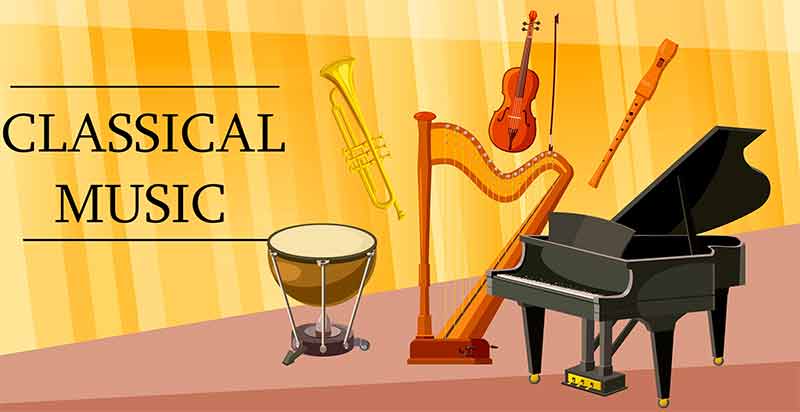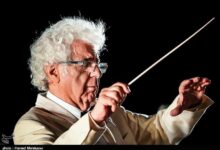Classical Music

We all know what music is. It is a whistle that you play while working, it is a song that you sing in the shower, how should it be defined?
Simply put, music is an organized set of sounds to create the beauty of form and expression of emotion. Classical music is like any other kind of music. The difference is that the sounds are organized differently and usually have a more specific structure. But “classical” composers often use folk songs, folk and folk dance rhythms, popular songs, and the like.
Classical music used to be called “long hair” music. Perhaps because List, Paganini, and other master artists were so preoccupied with the audience that they did not bother to go to the barber shop themselves. The situation was the same until the Beatles and various rock bands entered the scene and with their long hair took the monopoly out of the hands of classical music.
What is classical music?
When I like classical music, what do I need to know about it?
Yes, you do not need to know how to paint when you like a painting, or you do not need to know how to make it when you like a chocolate, you do not need to study music to love classical music. But the more you know, the deeper you enjoy it.
Since the ninth century, when some monks realized that sound is better in harmonic mode, music has become increasingly complex. With complexity, elegance also increases.
What is the difference between an oboe and a saxophone? What is the difference between a symphony and a sonata? You know they are different. But you can go ahead and get to know Termin, for example, which is the only instrument you can play without touching it. Or see what a symphonic poem is? Where music and literature come together. Classical music is a language. You can do your job without knowing the grammar and spelling of difficult words, but if you know this language better, your communication will be easier and you will enjoy it more.
The more you know, the more you like it
Many say that French is a beautiful language. If you listen to a Frenchman speak or sing, you will be amazed at the poetic flow of sounds, gentle changes in tone and the power of voice expression. But your perception of French is limited to these sounds. If you do not speak French, you will not understand what has been said or read, and your comprehension will be very limited.
The same is true in music. Even if you haven’t heard of Beethoven, you’ll be unaware of the amazing sounds of his sixth symphony, “Pastoral.” But if you know that this music describes a day in the village with the song of birds and summer lightning, then this music will take on completely new dimensions for you. Long before Lamancha, Richard Strauss described the adventures of Don Quixote as an orchestra. But if you do not know that the viola represents Sancho Panza, or the knight’s battle with Asia Minor with the cello and the wind machine (the device that makes the sound of the wind) is described, then you will lose half the joy of this music. In short, it will be easier to share the events and feelings of the composer if you look more closely at the elements of classical music.
Familiarity with classical music is simple
Learning the basics of classical music does not require as much time, talent, and effort as, for example, playing an instrument. Our intention in this article is to help you become a better listener and have more fun. First, let’s take a look at some of the key elements in classical music.
Rhythm is the pulse or heartbeat in music and it drives it. Every activity you consider, from breathing to walking, has a rhythm, and in music, the beat and beat usually determine the nature and type of music. For example, Gregorian songs have a slow flow. Baroque concerts have precise and regular ups and downs, and some music stops beating.
A melody is a sequence of notes with different modes that stick together to make something satisfying. When you come out of the cinema and whistle the soundtrack, you are whistling a melody. When a song by Schubert shakes the strings of your heart, or you involuntarily whisper the main theme of Rachmaninoff’s concert number two, it means that these composers have been able to compose melodies that will be remembered.
Harmony is the simultaneous sounding of two or more notes. Harmony enriches the sound of the melody. Emphasizes variable rhythmic patterns, and gives classical music richness and resonance. “Harmony is one of the main perceptions of the human mind,” said Aaron Copeland.
The color, resonance or tone of any singer or instrument causes the depth and variety of music. It’s like the difference between a black and white movie and a color cartoon. It’s like the sauce that the chef adds to the food, the fluid lines that the architect puts into the skyscraper. Imagine Richard Wagner ring set without brass instruments. Or imagine playing Beethoven’s “Four Elysées” with a trumpet instead of a piano. Then you will realize how color affects our perception. The combined sound of different orchestral instruments is called “orchestral color”. Sometimes wooden wind instruments prevail, sometimes string instruments are composers who mix and match these distinct colors to create the desired sound.
The combination of all these components and elements is the basis of classical music. The composer has to do these compositions, the singer or the musician has to perform them, and in each category there are endless variations waiting for the greedy listener to swallow. Our job is much easier, we just reap the rewards of their efforts.
What is classical music?
Think of it as a kind of architecture. Classical music is organized according to certain conventions of line and form. In this general division, there are several sub-divisions, each with its own style. For example, buildings of the same style can be compared. In music we can put Hayden and Mozart together, and we know that Bach’s style is different from Stravinsky.
You recognize when you hear
Even the most experienced musicians can sometimes not recognize Haydn from Mozart or Corley from Vivaldi. But by listening to a few notes, you can probably tell if it is classical music or some other type of music. Each type of music has distinctive features. Like the color of an orchestra in classical music. If you turn the radio, you will encounter a variety of music on different stations. But you will definitely recognize classical music.
Courtiers with culture
A singer was once asked what is folk music? And he replied that all music is folk music, horses that do not sing! “Folk music is the kind of music that no one has ever made,” Mark Twain said. In the Middle Ages, when songs and chants were composed that are still dear to us today, a kind of music was formed within the walls of castles. The kings and queens of Europe wanted higher musical expressions, so they brought oud, mandolin, and harpsichord masters to their court to play for them.
It did not take long for courtiers to compose songs for weddings, mourning, private banquets, and a variety of rituals and ceremonies. Some of these rulers were capable musicians themselves. Frederick the Great played the flute. And Louis IX danced in the court fins. And an important part of what is called classical music today is the product of the work of these cultural aristocrats.
A lot has changed since Handel sang for King George on the River Thames. Classical music is for everyone these days. We can listen to this music on radio and television. Let’s go to the concert. Or set up a set at home and listen to music in a cozy environment. Most major cities in the world have free summer concerts, orchestras perform music outdoors. And all kinds of music, from solo recitals to massive operas, are available to everyone and can be purchased at music stores.
Whose job is it?
Classical music is the product of composing work that organizes tones and sounds. Improvisation has little place in classical music. Of course, performances can be very different. Listen to a symphony led by Herbert von Karian and Leonard Bernstein. Then you may be wondering if they are both running the same text ?! Of course, they are performing a single effect, but variables such as speed, volume, and emphasis and emphasis make classical music always sound fresh and lively.
Complex texture and organization
Nothing is simpler than the non-harmonic melody of a Gregorian song. But when we look at deaths and madrigals whose melodic lines are intertwined, when we consider great symphonies, concertos and operas; We understand how complex the musical structure can be. Of course, this does not make it less fun, it just makes it harder for you to identify the musicians and actors.
A variety of classical music
Classical music is either an instrument, or a vocal, or a combination of the two. You can see the available settings for each of them below.
Instrument Music
Pieces are written for instruments only. It may be for a guitar alone or a 110-piece orchestra, but not for the singer.
* Solo means one. A cello. A trumpet. But solo sometimes means two, as when the main instrument of an insignificant accompaniment, such as the piano accompanying a violin solo.
* Duet means two equal partners: two identical instruments (for example, two guitars) or two different instruments (such as flute and bass).
* Chamber music is for two or more instruments that are of equal importance. However, here too, sometimes the accompanying role is assigned to one of them. The term was previously used to describe the place where the music was performed. Usually a small hall and not a large hall or hall. But today it is used for any kind of small orchestra.
* Instrumentation pieces are often called sonatas. Trio (three musicians), quartet (four musicians), quintet (five musicians) and so on. The string quartet, as its name implies, is for four stringed instruments. (Usually two violins, one viola and one cello). The wind quintet includes flute, oboe, clarinet, basson and horn. But a piano trio or piano quartet does not mean that three or four pianos are assembled. Rather, it means that the piano plays the role of a string or wind instrument.
* From October (eight musicians) onwards, musicians usually need a guide to get things done (which is the leader). Out of about 35 musicians, he is called Exeter Majlisi. Because they easily fit in the reception hall (especially if you live in the Palace of Versailles!)
* In the symphony orchestra, 60, 70 and sometimes more than 100 musicians are present on the stage at the same time. There are four main families of instruments in an orchestra whose members produce sound more or less the same way.
Stringed instruments include violins, violets, cellos, double basses, and sometimes harps. The musician either pulls a bow on the strings or lifts the strings with his finger. The brass instruments are the loud and shiny instruments behind the orchestra: trumpets, horns, trombones, tuba. Wooden wind instruments, as their name suggests, are made of wood and the musician blows in them.
Today, wind instruments have a variety of metal parts and components, and even some of them, such as flute and piccolo, are all metal. The percussion part is the loudest of all the parts and contains the things that you have to pound on. Sometimes this part of the orchestra is also called “kitchen” because it has everything you want besides the toilet.
Vocal Music
Vocal music is a sequence of musical sounds that come out of the human throat. This is perhaps the most basic form of music making, because it reaches the listener directly from the singer.
Song – Lead – In the Middle Ages, the troubadours went from castle to castle singing songs of love, passion and despair. And sometimes they got involved in local rumors and revealed what a courtier, for example, did to someone. In France, these songs were called “chanson”. Madrigal was vocal in five or six parts. And it was mostly poetry in the form of music. In Germany, singing was called “lead”. Lead was especially popular in the Romantic era. In the lead of composers like Schubert, Schumann and Brahms, we see the peak of emotion.
Sacred or Church Music – Gregory’s hymns resounded on the high ceilings of cathedrals, and the hearers felt the greatness of God. These songs were monophonic and acapella, meaning one voice and unaccompanied. In the 11th century, composers gradually developed polyphony for two voices. Mott was a prototype, and was generally a Latin-based vocal instrument performed as part of a church service. Copper, the religion of sanctification, flourished during the Renaissance and has since become an integral part of classical music. Composers from Mozart to Leonard Bernstein have made copper, some of which are not as heavy as they should be.
* Choir – Choral music is a form of sound adjustment. We have women’s choirs and men’s choirs, but many choirs are mixed to cover the entire range of sounds, from soprano to bass.
* Opera – When a theatrical story is performed with vocal music and an orchestra is the basis of it, we are dealing with opera (if a biblical story becomes music, we are faced with an oratorio). Opera can be fun or tragic, short or long, imaginary or real, uplifting or frustrating. At the same time, the opera can be exciting and very satisfying.
Why listen to classical music?
Listening to classical music takes us out of the everyday world with all its stresses and strains. “Wild animals rest here,” was once written at the entrance to Lincoln Center in New York. It may seem strange, but Bartکk’s inconsistent harmonies or the loud screams of the Valkyries bring solace and relief. We automatically resort to music when we are upset or angry or frustrated, and this is not a new phenomenon.
Has artistic pleasure
Imagine the music of Picasso or Rembrandt. You do not have to be an artist either clean or serious to enjoy classical music, but by listening to classical music that lifts your mind and psyche.
It is inspiring
German expressionist Vasily Kandinsky painted with music. More precisely, he painted music.
His canvases are visual examples of the sounds he hears. But composing music, like Scriabin, made music to bring certain colors to life. And Bliss’s heir apparent composed a full-color symphony. These charts, whether visual or audio, convey emotions and feelings, enhance our artistic awareness, and even boost the energy within us. It is no coincidence that Olympic skaters do all their incredible jumps and spins with music, or that many civil rights activists or revolutionaries gain confidence and strength by singing anthems and playing music.
That’s beautiful
Beauty is in the eye of the beholder or the ear of the listener. Some music may be mesmerizing in one culture but it may seem ugly in another. We individuals also have different musical judgments. Some of us may not like the repetition of baroque concertos. But Vivaldi Four Seasons is one of the most popular pieces ever made. A Parisian critic wrote: “These chromatic meioms of a professional cat will never replace an impressive tonal melody.” This critic was not referring to an avant-garde symphony, but to Garman from Bayes! The moral consequence is that if you find classical music yourself and the world around you.
Do not be afraid of words
Those who do not understand classical music use words such as “heavy” and “serious” about this music. Is there really anything lighter than a Strauss waltz and less serious than Mozart’s “musical joke”? Sometimes a classical piece is distinguished from a non-classical piece in that it is said that a classical piece is made for an orchestra. But this is not a good way to distinguish a classical piece from a non-classical one. Because today we see that many pop groups also use orchestras (also classical orchestras).
In the present text, we have tried to acquaint you with some classical music terms such as color, tone, harmony, concerto, and the like. These are not complicated and incomprehensible concepts. Perhaps Wagner and Beethoven (not Kalas and Caruso) intimidated leaders and managers. But the listeners enjoyed their work. The more you know about classical music, the less afraid you become. Ultimately, everything is made up of rhythm, color, tonality, and texture, which are simple concepts. You should not be afraid of words and expressions.
Elements and components of music
As we know, water is made up of two parts, hydrogen and one part, oxygen. And carbon dioxide is made up of two parts oxygen and one part carbon. Music is also made up of basic elements. Fortunately, you do not need to allocate to understand and receive music. Just keep your mind open and listen to the music with your ear.
The nature of classical music
Music, whether the simplest folk songs or the most complex opera collections, is made up of fundamental components, the most important of which are melody, rhythm, harmony and tonality. Some music has spiritual power. Some are funny, and some are noticed simply because of the beauty of the sounds.
Compilation
The components we mentioned can be given texture and structure. The composer uses all these tools to create sound. The composer can make a piece for string or wind, brass and percussion instruments, or a combination of all of these, which we call a symphony orchestra. The composer may incorporate ideas into instruments such as guitar or piano, or combine electronic sounds, or blend words with music. The composer is able to create laughter or anger, scenes of terrible battles, or conflict of characters in our minds, or make the scene the battlefield of giants.
In fact, many things can be said about classical music. Just as a skilled chef can cook delicious food for our tastes and even our eyes, a composer can combine different components to create an effect that pleases both our ears and our minds.
Of course, the work of a composer is also different from that of a chef. Because the performer also plays an important role in music and can give new moods to the piece of music with its ups and downs. Of course, the composer makes the work; But the performer can increase or decrease the tone and color while following the composer’s formulas. In jazz, improvisation plays the leading role, but in classical music, while being faithful to the composer’s work, there are different ways to play instruments and sing sounds according to intentions and rhythms.
In some works by John Cage and other composers, the improvisation is either entered in the score or the notes of the piece are chosen at random. Music varies from performance to performance based on random components. But the composer did not mean anything else. In other words, from the predictable forms of Baroque dances to the most unstructured modern works, the composer is the chef who makes the musical food.
Rhythm
Many poems have rhythms: the lyrics often have rhythmic patterns (tick-tock, ding-dong, etc.) but the creative use of rhymes, prepositions and other tricks in music also helps to get the sound. As well as helping to understand the specific meaning of words. Rhythm is fundamental. As if there is no heartbeat and even no air flow in and out of the lungs, life stops. Children become accustomed to rhythmic touching and respond to songs very quickly. Of course, it is very difficult to follow rhythmic beats in difficult works such as Scriabin’s “Trance Poem”, but in any case, if we do not align and do not want to understand these types of rhythms, there will be no music at all.
The march has a left-right rhythm. During the parade, we wait to move according to the weight and beat of the military music, but the waltz is one-two-three. Mazurka is also three-fold, but in the form of one-two-three, that is, the emphasis is on the second multiplication.
Time and speed
The word tempo in Italian means time and indicates the speed of music and is related to rhythm. Because it shows how fast you have to go from one emphasis to the next. It also controls the speed of harmonic changes and shapes our emotions in the piece. Composers mark the speed of the performance with special symbols and use the metronome (a device for beating at different speeds). Performers often follow these composers’ instructions with a bit of freedom of action and taste. Sometimes they perform slower to bring tone and calm to the music, and sometimes they perform faster to add to the excitement of the piece.
The tempo symbols are entirely Italian. Here are some common signs:
Largo: Very slow, very loud.
* Grave: The more serious.
* Lento: Slow.
* Adagio: Like Lento. Slightly faster than Largo.
* Adagietto: Slightly faster than Adagio.
Andante: The word means “walking” and “flowing”, like walking, at a moderate speed.
* Andantino: A little faster than Andante.
* Moderato: Mild. This word is used in conjunction with another word, like Andanto Modrato, meaning do not be too stubborn in Andanto.
Allegro: means living, relatively fast.
* Allegretto: Less than Allegro.
* Allegro Molto: “Multo” means too much or too much.
* Vivace: Very sharp.
* Presto: The faster.
* Prestissimo: faster than a swallow.
You may hear a performance in which the composer Adaju has become a swallow. Or vice versa; However, even minor changes in tempo may change the mood and character of the work.
Fixed multiplication
Fixed multiplication has a hypnotic effect. Composers often use fixed beats to evoke a “primitive” feeling.
Patterns
In base multiplication you can find many patterns that sometimes complement each other, and sometimes collide with each other. An important part of Baroque music has energetic, constant and repetitive rhythms (some people who do not like this kind of music call it “sewing machine music”). But the textures are rich and the melodic counterpoint contrasts the themes with perfect skill and mastery. Bach, Vivaldi and Thelman have introduced delicate and intricate decorations in their works. why not? The word “baroque” comes from architecture to other fields. It has special implications. Such as construction and method that is skillful, twisted and effective.
In the classical period, the rhythms became more subtle and minute. In the Romantic period, the poetic spirit prevailed and the freedom of rhythm became prevalent. The twentieth century, with technological advances and the energy and power it gained, fueled experiences in rhythm. Bartok, Stravinsky, and many others used “pulse rhythm.” Several independent patterns reach the skilled listener at the same time.
Syncope
Syncope occurs when we do not hear the beat we expect. Or, more technically, it is the shift of emphasis on multiplication that is not usually emphasized. This surprise may be annoying or pleasant. For most of us listeners, this emphasis is beyond pleasant multiplication. This syncope is present in jazz, blues and rhythm. In classical music, syncope also creates a kind of suspense or mystery. The word syncope comes from a Greek word meaning “to cut off.”
Beat promotes music
It beats the rhythmic beat of a march or waltz, but it also has symmetries in the vocal pieces. Sometimes it is the poem that drives the music and sometimes it is the melody that carries the poem. The sharpness and slowness of the piece, the repetitions of the rhythms, or how they are changed, all contribute to the progress of the piece of music.
Collection of notes
A melody is a sequence of musical notes that form a recognizable identity. It could be a birthday song, or a complicated Mahler symphony. “Melody is the same as poetry. It has the same symmetries and rhythmic divisions, it is subject to the same motives of pressure and emotional release,” said musicologist Carl Haas.
Sentence
A melody is usually made up of smaller units, which we call motifs or sentences. These motifs or sentences may be as short as a two-note Coco sound (also found in Mahler’s First Symphony). They may consist of two or three consecutive notes in one step, or cover an entire octave.
Simple or complicated?
If a melody is independent or dominates a harmonic accompaniment, it is easy to trace, but when two or more melodies come together we hear a mixture of them, not separately.
“Fugue” consists of several parts (we often call them “sound”, whether they are played or sung). And each sound imitates the previous sound. The initial motif is called “subject” or “theme”. The imitations are called “answers” and the parts between the complete entries of the sounds are called “episodes”. Someone jokingly said that fugue is a piece in which instruments are added one after another and the audience decreases one after another.
Pleasant
By “melodic” we usually mean a piece that is pleasing to the ear, and throughout history an important part of music has been made for this purpose. The court composers did not dare to make something that the kings and queens did not like. Even Hayden, with all his greatness, had the task of making works that ranged from the dinner table to the marquee plays. Of course, great works of art may not only be unpleasant but also confuse us. They may indicate political protest. To depict painful and tragic events, and to reflect the contemporary spirit in our time, which is called the “Age of Anxiety.” What wants to be “pleasant” must include any effect of imagination, originality and power. Today we do not just need peace and quiet. Music can give us many other things.
Harmony
Harmony means the simultaneous sound of two or more notes. It underlies the melody and gives it depth and breadth. Harmony means harmony and compatibility. But in music it does not mean exactly that. The notes that sound together may also be unpleasant. In the Middle Ages, harmony meant that singer (a) and singer (b) no longer read the same notes at the same time. Today, however, everything is allowed.
Consider a note, no matter what the note. Consider another note. There is a “gap” between the two. And the distances become a harmony when you play these two notes together. They may become a chord, although some people are adamant that at least three notes must be played together to form a chord.
Harmony enriches the melody. Emphasizes rhythmic patterns, and changes the mood of listening. In the most common form, the melody prevails and the chords adorn, support and reinforce it. When all the chords go together, and usually the melody above them, like church prayers, we come across what musicologists call “homophony.” When harmonies are produced by playing between different melodies, we are dealing with “polyphony”. In the Renaissance and in the Baroque period, polyphony ruled. In the classical period there was a definite turn in the direction of melody, which culminated in the romantic period. Of course, Bach composed 7 huge melodies. And in the twentieth century we have famous examples (such as “Adagio for String Instruments” by Barber).
Birth of Harmony
We have pictures of ancient Egypt and ancient Greece showing them playing various instruments. Hence, perhaps the harmonic art is older than what we know. But in the ninth century, when the Church in Europe considered harmony to be the work of the devil, some rebel monks decided to add a second voice to the songs. And finally they added the third and fourth voices. Around 1000 AD, in the midst of Romanesque art and architecture, composers began experimenting with music for two voices. That each voice went its own way. This was a decisive step in the evolution of classical music because it was from now on that Western music became distinct from Asian and Middle Eastern music.
As the Renaissance spread to Europe and art re-emerged from the sovereignty of the church and interest in science revived, religious and non-religious composers developed their own harmonic compositions, combining up to six different soundtracks. By the time Elizabeth Madrigal became popular, composers had turned to purely non-religious subjects, such as political and emotional love.
* Sources and references are available in the editorial office of Artmag.







